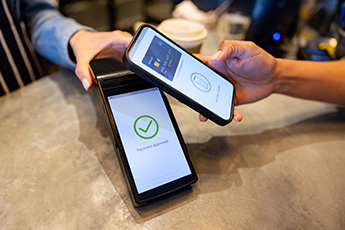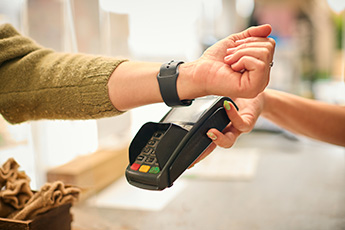Items include
- 3 Whitepapers
- 4 Podcasts
- 150 BID Newsletters
payments
Whitepapers

Cross-border payments are changing and business owners expect to transfer money quickly. Swift GPI allows community financial institutions to meet their customers’ needs and generate additional fee income for their institution.

The Federal Reserve Banks are set to adopt the ISO 20022 message format for the Fedwire Funds Service on July 14, 2025. This pivotal transition will mark a significant step towards standardized, efficient, and interoperable financial messaging.

Your customers aren’t going to wait for faster payments. The ability to clear and settle payments in real time provides money management flexibility and full access to immediate funds. Understanding the payment options available to you and how to get started implementing them can help pave the way to keep customers happy.
Podcasts

In this episode of Banking Out Loud, Fiserv payments experts Paul Sullivan and Justin Jackson join PCBB’s payments expert Sheila Noll to discuss the rapidly evolving faster payments landscape. Their conversation touches on the importance of strategic thinking and collaboration with partners, while also driving home the need to view faster payments as an opportunity to better serve customers and differentiate your institution.

Podcast about the different types of digital assets, current regulation as well as thoughts on what could be next. We also explore blockchain technology with a look at current and potential uses related to banking.

A discussion with PCBB's Allen Sztukowski, an active participant in the efforts to modernize real-time payments, on how the payments space has changed over the years, and what efforts are being made today to modernize it.

In this part 2 of our payments episode series, host Sonia Portwood sits down with PCBB's Allen Sztukowski to discuss what the future of real-time payments looks like. Including the soon-to-launch FedNow program, anticipated technology and functionality changes, and tips to help you prepare.

CFIs of all sizes employ various strategies to successfully prevent and detect check fraud. But could another strategy be to go upstream and encourage business customers to adopt digital payments?

By 2027, 51% of e-commerce purchases will be via digital wallet. We discuss why digital wallet share is important for CFIs, along with strategies to get the top spot.

Recent regulatory changes have cleared the way for financial institutions to delve into crypto. We outline the latest developments and safe strategies for CFIs to start exploring crypto offerings.

Many businesses still rely on checks for B2B payments. We discuss how CFIs can support check usage among their SMB customers while promoting the adoption of modern payment methods.

Faster payments haven't led to more fraud for two CFIs, thanks to effective risk mitigation and FedNow's security features. We highlight their experiences and the security features deterring fraud.

Buy Now, Pay Later options are gaining traction among small businesses as they seek flexible financing solutions to fuel growth and recover from economic challenges.

Positive pay can help you flag fraudulent checks before funds are issued, yet adoption rates are just 29%. We discuss the benefits of positive pay and how to increase its usage.

The right payment platform can create substantial opportunities for a CFI — and a CFI can use what it learns from finding the right payment platform to help business clients do the same. We discuss the factors a CFI should consider when selecting a payments platform.

For small business customers, waiting for payments can take a while — often at least 30 days. Checks and invoices get lost or go to spam folders and vendors charge fees to transfer funds. Doing more to remove these pain points can help strengthen existing relationships and allow your small business clients to have better cash management. We discuss ways to help small business customers get paid quickly and easily.

As the payments space rapidly evolves, CFIs have a significant opportunity to strengthen their relationships with SMB customers by offering integrated, secure, and cost-effective payment solutions that go beyond basic processing.

Global B2B activity is poised to reach $111T in 2027, yet businesses are looking to nontraditional providers to fill their needs. Now is the time for CFIs to take a fresh look at their commercial payment services and revamp them to attract business customers with B2B needs before they land elsewhere.

The volatility of the foreign exchange rate market can be challenging on your small business customers that do business internationally. We explore FX forward contracts as an option you can offer to provide more certainty in this area, thereby increasing customer loyalty.

Embedded banking allows CFIs to provide financial products and services through non-bank, third-party partners such as retailers and service providers. In this second part of our embedded banking series, we explore ideas of how CFIs might partner with non-bank organizations to offer embedded banking services. We also address some of the legal, compliance and technology challenges associated with launching embedded banking.

The pandemic caused many smaller companies to adopt digital technologies that expanded their ability to reach customers across the US and in other nations. Many of the companies say that cross-border commerce is a way to grow businesses and keep up with the competition. As a result, CFIs with international payment solutions may have opportunities to strengthen relationships, add new customers, and grow fee income.

Businesses and consumers prefer the convenience of electronic payment methods. So, an electronic bill presentment and payment (EBPP) platform is helpful for CFIs to retain customers, compete for new clients, and stay viable. Not all EBPP platforms are alike, so we discuss how to choose the one that benefits your institution the most.

Understanding why paper checks are still a popular way of paying business invoices can help CFIs assist their customers in making the transition to electronic payments. We discuss the reasons businesses still use paper checks for B2B payments and the benefits of switching to EFT.

The US dollar is at parity with the euro for the first time in 20Ys, and up against numerous other foreign currencies. That’s not necessarily a good thing for companies that do business overseas. American goods are more expensive, and the dollar’s strength deflates the value of funds earned overseas. We discuss ways you can support your commercial customers who have international business ventures.

Virtual payment cards have been around for a while. But, their use is increasing. Global virtual card spending is expected to reach $355B in 2022. Businesses are finding several uses and benefits in using virtual payment cards. Community financial institutions will want to take note, so that they can be prepared to best support them.

Ninety-five percent of text messages are read within three minutes. With consumers’ reliance on texting, it is no wonder that the latest payment option, text-to-pay, is gaining momentum. It gives users the ability to pay through a link on a text easily and quickly. Let’s see why your small business customers may start finding it attractive.

Some community financial institutions may not think that cross-border remittances are in demand in their communities. Yet, in its November report, the World Bank projected growth of 7.3% of remittance payment volume in 2021. Could some of this spill over into your footprint? Here are three ways to successfully provide remittance services.

The pandemic threw a major curveball at everyone, especially small businesses. Many changed gears and moved to an e-commerce model, which helped them survive. With fewer geographic barriers, global payments soared and the value of global digital payments is expected to increase 22% YoY in 2021. Here are three ways that community financial institutions can help their customers continue to thrive with global payments.

Small businesses are busy overseas. They are looking for more opportunities to not only grow, but sometimes survive. Last year’s e-commerce boom made international business even easier for many businesses. Small business international wire transfers increased to 17% last year from 10% in 2019. Is your institution supporting its customers with international payment solutions? If not, the competition will.

With Square officially becoming a bank and Google and Amazon intent on staying active in the financial services industry, competition is heating up. What are these technology vendors doing and how should you ensure your customer relationships are solid so you remain competitive? We answer those questions for you.

The pandemic caused many things — a coin shortage was one of them. The residual effects of this shortage are still felt even today. We update you on what the Fed is doing, why coins are still important (even in this increasingly cashless economy), who loses out in a cashless society, and how community financial institutions can help their small business customers adapt.

The Federal Reserve is making good progress on its FedNow Service – it expects to launch it in 2023. Before we know it, 2023 will be here. So, to keep you informed, we are providing you with the program details, ISO specs, program advantages, and some information on the pilot that is underway. Since we are participating in the pilot, we will give you these updates regularly.

As your small business customers expand to Canada, Mexico, and beyond, you will want to grow with them. If you provide international payment services, you can support them and gain valuable fee income. We map out what these customers are looking for in international payment solutions.

Digital disbursements give businesses a smooth and immediate payment process. With global digital payments expected to hit $7.64T by 2024, opportunities for businesses to seamlessly make payments is ramping up. Community financial institutions can help them while finding benefits, such as reducing expenses, increasing transparency, generating fee income, and assisting with customer profitability.

Javelin Strategy & Research finds that businesses accepting digital payments of all kinds increased to 53% during the pandemic. This creates five opportunities for community financial institutions.

Do you want to acquire new customers? Merchant businesses can provide you with more revenue and are cross-sold on more products faster.

For our monthly I&I issue, we share questions on women and minority-owned businesses, digital-first credit cards, and remote employee feedback.

Faster payments are here and the options are expanding. What you need to know.

Coins are in short supply due to the pandemic. Here are a few strategies for community financial institutions and their businesses to manage through this shortage.

With COVID-19 and its lockdown effects, acceptance of mobile apps for credit cards has certainly increased. We provide you with some insights to prepare for this trend.

Contact EMV chip technology has its feet firmly planted in the US and adoption continues to increase. We provide the latest news.

McKinsey reports that more people and entities will regularly use international payments in the next 5Ys. Is your institution ready for this?

Many community banks are looking to increase their back office efficiency and provide faster availability of funds, with checks between the US and Canada. We explain how this can be done.

Almost 33% of consumers and business owners agree that new technology will lead to safer payments. Subsequently, businesses are increasingly accepting card and digital payments. Can your bank support them?

"Self-driving" payroll, which is on-demand access to one's pay, is gaining steam, particularly with gig workers, and banks are taking notice.

Contactless payment has struggled in the US. But, it appears that is about to change.

SMBs have converted to many digital services. Yet, e-invoicing still has not taken off. We provide some insight.

In the business world, checks have been the preferred method of payment for eons. That is definitely changing. How to prepare your business customers.

Banks are paying attention to behavioral economic studies as they seek to understand how people make purchases in order to inspire desired actions among their customers. We have some highlights to help.

Global digital payments volumes are expected to increase by nearly 11% through 2020. What community banks should know to guide their business customers on the technology and the providers.

According to a recent survey, SMB usage of digital payments surged 38% from 2017. How can your bank leverage this opportunity?

According to a recent survey, one in five small to medium business clients said they were ready to leave their banks in the next 20 months. We provide you with their reasoning and show ways to prevent it from happening to you.

While digital banking is pushing checks aside, those who still write checks are a financially mighty group. What you need to know to hold onto these customers.

Following tradition, we're taking a look back at your favorite articles from this year as we BID adieu to 2024. We're kicking the series off with our most popular article of the year. This spring, two of our customers were targeted in a fraudulent wire transfer scheme, with one unusual twist — the victims weren’t the CFIs’ customers, but the CFIs themselves. We provide details on how this cyberattack unfolded, as well as tips to protect your CFI from similar threats.

Recently, two of our customers were targeted in a fraudulent wire transfer scheme, with one unusual twist — the victims weren’t the CFIs’ customers, but the CFIs themselves. We provide details on how this cyberattack unfolded, as well as tips to protect your CFI from similar threats.

Mobile wallet technology is becoming increasingly popular. But, just like any technology rapidly on the rise, there are growing risks to consider.

Despite rapid growth in cross-border payments, there are still challenges in areas such as currency conversion, fees, security, and settlement delays. We detail possible solutions.

The need for speed has become a central goal for cross-border payments. Smaller businesses stand to benefit from improvements. We discuss how cross-border payments can be used to encourage customer loyalty.

The European Payments Initiative is moving forward and is poised to change the global banking landscape if it is successful. We discuss what those changes look like and how they could affect US financial institutions.

Wire processing automation was spurred on by the pandemic. Yet, there are several reasons to consider it for the long-term, including faster processing, more money saved and earned, and fewer errors. We provide you with all the information you need to get started.

If you provide international wires for consumers, you will want to know about the latest regulation modification. We give you the specifics.

Millions of international wire transfers go through the financial web each day. But, wire fraud can and does happen. What one bank's lesson can teach your bank.

The Federal Reserve has extended the ISO® 20022 implementation deadline for the Fedwire® Funds Service to July 14, 2025, giving CFIs more time to prepare. Benefits include enhanced payment efficiency, stronger fraud detection, and improved interoperability. With the deadline approaching, we explore how CFIs can use this extension to refine systems, train staff, and support business customers.

Target is the sixth major retailer to ban checks, due to low usage, high processing costs, and fraud. However, check usage remains a force within certain pockets of the economy.

Digital-first payment cards will account for $9.1T in spending by 2027. We discuss the benefits for customers and explain how CFIs can benefit by offering customers virtual payment cards.

It’s been a decade since “wearable payments” technology was introduced. After years of on-again, off-again interest from banks, wearable payments are becoming practical and useful for CFIs and their customers.

Due to high production costs, the US Mint will press the very last penny early next year. We discuss the impact for consumers, businesses, and CFIs.

The July 14 ISO 20022 cutover is nearly here. Core systems may handle much of the technical work but CFIs still have key roles to play — especially when it comes to operations, compliance, and customer support. Here's what to know now.

Debit card and check fraud are both on the rise. We discuss the trend, including how CFIs can maintain vigilance and protect their customers.

As federal payments shift to faster digital methods, CFIs can support SMB clients by modernizing payment tools, encouraging digital adoption, and delivering real-time capabilities that meet evolving business expectations.

Ongoing advancements in biometrics have added convenience and additional security for consumers and retailers alike. As demand for biometric payment options increases, it gives CFIs another opportunity to provide additional services for business customers.

Central banks are working to make CBDCs and stablecoins a reality. From access to transparency and security measures to technology issues, we review the benefits and the challenges that CBDCs pose.

P2P payments have become increasingly popular, but their most convenient attributes also make them ripe targets for fraud. We discuss tips CFIs can provide customers to avoid becoming victims.

Zelle is reworking its refund policy regarding fraud, a change that could potentially prove costly for CFIs. Before jumping ship from Zelle, however, organizations need to be aware of both the benefits and drawbacks of the service and how customers would react to losing the payment service.

According to a Federal Reserve survey, 90% of businesses said they expect faster payments within three years. Many businesses see this as a way to automate operations and satisfy their customers. Community financial institutions should be preparing for faster payments now as competition is intense. Here are four recommendations to prepare for faster payments.

The pandemic has impacted financial institutions in many ways, especially with the explosion of digital payments. This increase caught the attention of cybercriminals, as eight out of every ten fraudulent transactions entail a card not present (CNP). Here are four steps community financial institutions can take to help prevent CNP fraud.

Faster payments are growing in popularity, but so is the opportunity for thieves. What your institution can do to stay safe.

Digital payment channels are becoming faster and more convenient but fraud is a big concern. What your bank should know.

The Federal Reserve has proposed shrinking the regulated interchange cap for debit cards, but banking associations and merchants oppose the change. We summarize each side’s response.

Voice banking, boosted by developments in AI is gaining traction. We discuss the benefits of voice banking and where improvements are needed to increase value for banking customers.

The Federal Reserve is considering keeping its Fedwire® Funds Service (Fedwire) and the National Settlement Service (NSS) running seven days a week, including holidays. We detail the potential benefits and costs.

CFIs and other banking operations could profit immensely from creating embedded finance partnerships, where CFIs offer their digital banking services to be integrated into experiences for a third party’s customers. We review the growth potential for embedded finance partnerships and how to get started.

As a growing number of retailers and service providers go cashless, there is a rising need for digital payments for kids — a multi-billion-dollar opportunity that few financial institutions have tried to meet. We discuss the benefits of creating a digital payment option for children under 13 and how to get the word out if you decide to throw your hat in the ring.

BNPL has become increasingly popular and is expected to grow in the years to come. The market, currently dominated by fintechs, is ripe for regulation, opening the door for traditional financial institutions. CFIs may want to react quickly to this latest disruptor. We discuss the key considerations for CFIs entering this space.

Sheila Noll, PCBB’s Chief Operating Officer who served on the Federal Reserve’s Faster Payment Task Force, shares what it took to get FedNow® Instant Payments up and running and her advice for CFIs.

This week, we will revisit the top BIDs of the year as we say goodbye to 2023. Our first stop down memory lane brings us to this article from Feb 15: Americans are using cash less frequently and making payments more often by credit card or through payment apps. CFIs will need to provide both advanced digital capabilities and a willingness to handle cash banking as well.

As we visit this year’s most popular BIDs, we look at this article from Feb 8 on faster payments: The FedNow® Service works between financial institutions, in contrast to consumer-centric payment apps. We take a deep dive into the details.

Financial institutions are finding that instant payments come with their own array of issues, including outages, fraud, and reputational challenges. We review these challenges and provide ways to handle them if they arise.

Checking accounts are long beyond their heyday, but that doesn’t mean that they don’t still hold value for CFIs. We review the decline of the physical check and the staying power of checking accounts — and how to keep them relevant to small and medium-sized business customers.

Biometrics-based payments are growing, accelerated by consumers’ preference for contactless payments. Some institutions, as well as Mastercard and Visa, are now piloting such programs — and CFIs can take advantage of this opportunity. We review the benefits and privacy concerns.

CFIs can strengthen their relationships with business customers by partnering with a third-party merchant service provider that includes text-to-pay capabilities within its payment processing platform. By enlisting vendors that offer standalone solutions, CFIs can also offer text-to-pay to their retail customers who want to make loan payments via text. We delve further.

Central banks, including @Federal Reserve, are looking at possible cryptocurrency opportunities. An update on their progress and thinking.

The long-promised Federal Reserve instant payment system, the FedNow® Service, officially debuts in July 2023. CFIs could see some important benefits from participation. We discuss use cases and benefits of FedNow instant payments as well as how to prepare for the service’s launch.

Donations are down for many nonprofits since 2021, despite the fact that the need for their services continues to grow. Contributions have traditionally come in via checks and cash. A buy now, pay later platform partners with financial institutions to enable digital contributions that donors can pay off over time.

Pay by bank, a service that allows consumers to log into their bank accounts during an online purchase rather than entering a credit card, will debut as a new efficient payment method this year at online US retailers. While the service is more secure and eliminates the need for retailers to store consumer credit card data, it also means no fee revenue for credit card issuers.

The financial industry’s largest players are gearing up to introduce a new digital wallet aimed at competing with behemoths like PayPal and Apple Pay. Though it is still unclear how everything will play out, CFIs should keep a close watch on what they are planning while continuing to focus on their own digital offerings.

About 50% of people use at least two finance apps, according to Mambu worldwide research. So, how can community financial institutions keep their customers engaged with such a plethora of apps? Understanding app usage and what your customers are looking for in finance apps will put you on the right path to respond to the plethora of finance apps.

Are mobile wallets worthwhile for community financial institutions? We show you how one of your peers succeeded through the power of recurring expenses and the use of data mining.

Community financial institutions are now getting in on the mobile wallet phenomenon, as more customers demand this service. Is it time for you too?

The percentage of banking customers who used mobile apps to pay bills jumped by 30% in 2017 vs. 2016. We discuss some of the ways community banks can compete with bill pay services.

Mobile wallets have been all the rage. But, are they still? What a new study reports which could be important for your bank.

The Office of the Comptroller of the Currency has an innovation agenda and a special purpose payments charter is part of it.

In our new BID feature, "Inquiry and Insight", we provide questions from readers and bankers and do our best to give you relevant, insightful answers.

Decentralized finance (DeFi) is in its early stages. So, do community financial institutions need to follow this new trend? Yes. One big bank has dipped its toe into these waters and more are likely to follow. Not only that, but also DeFi is seen as a viable funding option for SMBs and the unbanked. Here is what you should know.

Real-Time Payments bring a new age for payments, as early as this year. But, as all new technologies, there are risks. Ways to mitigate these risks.

Buy now, pay later (BNPL) installment loans have been rising in popularity. Around one in three American digital shoppers have used BNPL to finance purchases, according to LendingTree. POS e-commerce installment payments are expected to reach $680B globally in 2025. Here are the things you should know about BNPL.

Embedded banking could help CFIs expand into new markets, acquire new customers, and increase deposits. While there is huge potential for embedded banking, some CFIs are hesitant to give it a try due to perceived complexity and high cost. In the first of a two-part series, we discuss benefits and trends related to embedded banking.

While QR codes have been around for two decades, they are making a comeback with contactless payments. Are they here to stay?

A new report provides findings on the latest payment trends. We offer you some insights on contactless payments, emerging technologies, and person-to-person payments to help with your planning.

As purchases become largely cashless due to COVID-19, the unbanked suffers. Ways you can help.

According to the Federal Reserve, 83% of consumers, ranging from the Silent Generation to Gen Z, routinely use mobile payment apps and digital wallets. Some users even keep a balance in these apps, treating them like makeshift checking accounts. With the popularity of social payments crossing the generational divide, integrating with social payment apps is a necessity for financial institutions to remain competitive.

Challenging economic conditions coupled with the boom in embedded finance mean that BaaS is an attractive opportunity for CFIs seeking growth. We look at the BaaS market, various key success factors, and how some CFIs are capitalizing on this opportunity.

Fueled by innovation, emerging technologies, and customers’ changing expectations, the payments space is evolving at a rapid pace. We look at some of the top payments trends and suggest ways in which CFIs can ensure they make the most of these opportunities.

While many daily tasks are beginning to resemble pre-Covid life, some habits picked up during the pandemic are likely to continue, including the use and expectations of contactless digital payments. We explore how to embrace this perpetual payment trend as it continues into 2023.

CFIs that want to issue credit cards have a new alternative to the agent bank model and the cost of investing in their own credit card-issuing system. They can leverage CCaaS fintechs. CFIs get more income and control — customers get broader product offerings and a more digital experience. We explore this option more.

By 2H 2023, the Federal Reserve is expected to debut its instant payment service FedNow. The service is intended to work between financial institutions, in contrast to consumer-centric payment apps. We take a deep dive into the details.

Americans are using cash less frequently and making payments more often by credit card or through payment apps. Yet, many CFI customers still like having cash as an option. To compete with fintechs in a future where less cash changes hands, CFIs will need to provide both advanced digital capabilities and a willingness to handle cash banking as well.

Several community financial institutions don’t believe that they need real-time payments. Some myths around these payment systems make them sound like more work than they are worth. We review five big myths around real-time payments and explain the facts to help you better determine your payment strategy.

According to PR Newswire, digital currency’s global market will grow by a compound annual growth rate of 3.5% between 2021-2026. While private digital currency adoption has surged, governments are taking note of this market and exploring central digital currencies. We provide you with the developments along with five steps to take in preparation of digital currencies.

Post-pandemic supply chain shortages are affecting many areas, especially computer chips. This could impact the availability of the chips used in bank cards. Both card-issuing financial institutions and their customers would suffer as a result. We provide the lay of the land and give you three ways to mitigate the effects of the chip shortage proactively.

Overdraft fees have taken center stage lately. Ally Bank announced it will eliminate overdraft fees for its customers, while several other financial institutions have been redefining their overdraft approaches. We provide you with the current background on overdraft fees including the reasons why overdraft fees are in the spotlight right now.

The tech giants have been expanding into the financial industry in various ways. Previously, Facebook tried its hand at cryptocurrency with Libra, which was shot down by the regulators and dismissed by investors. Now, Facebook returns with USD-backed Diem, which is issued through Silvergate Bank. What does this mean for the payments industry and community financial institutions specifically?

Many small businesses were hesitant to include digital payment options pre-pandemic. Now, 44% are accepting contactless or mobile payments, according to a Visa study. As businesses assess their payments approach, community financial institutions should be right there with them. Here are three strategies to support your small and medium-sized businesses.

The chip shortage keeps going. Supply issues continue wreaking havoc on many industries, including banking, with some chip deliveries taking up to 20 weeks. Because of this delay, over 1B cards globally could go unissued. We lay out six strategies to minimize the effects of the card disruptions.

The rise in digital payments and decrease in cash usage, prompted by the pandemic, have left their marks. These trends are only continuing. Community financial institutions should take this time to review cash transactions, along with the cash in branch vaults, with these trends to ensure their cash strategy is up-to-date.

Treasury management services are needed by businesses more than ever these days. Are you ensuring that all these opportunities are properly addressed? With 66% of small businesses stating that they face financial challenges, cash management is especially important. Here are three tips to fully support your customers with their treasury management requirements.

Many consumers are shopping online, but many value the in-store experience with contactless shopping options. Contactless commerce is growing with the advancement of new technologies. “Pay-by-face” and RFID are two of these technologies that are finding more traction these days. We cover the latest in contactless commerce technologies.

Summary: Central bank digital currencies (CBDCs) have been in the news for a while now. Yet, as some countries advance more dramatically on this front, misconceptions have sprung up regarding the progress, impact, and representation of a US digital dollar. We address some of these misconceptions and provide three steps to prepare for a US CBDC.

Discussion over the rules governing faster payments is still ongoing at a federal level. Meanwhile, customer adoption of existing real-time payment solutions continues to increase, with many new products on the horizon. Community financial institutions have a lot to think about before providing faster payment capabilities. Here are three steps to get you ready.

Vertically-oriented payment cards have been around since 2018. Yet, they have seen a burst of issuance since last year. Will more financial institutions use payment cards with a vertical layout? We explore which institutions are issuing them, why, and the benefits to your customers, especially those with disabilities.

The switch from 6-digit to 8-digit BINs has been in the works since 2015. But now, the first deadline is here. Community financial institutions need to check on their accounting systems to determine if they are sufficiently prepared. Here are a few items to assess the impact on your institution and communicate with customers, especially business customers.

The decline of checks has been happening for years. But, with the explosion of digital payments during the pandemic, will checking accounts cease to exist? We explore this topic further and provide community financial institutions with four approaches to keep checking accounts relevant for their customers.

Zelle’s dominance and cost spurred the development of an alternate payment system designed for CFIs, called CHUCK. The question is, will its open architecture be enough to woo users and secure a place in the competitive P2P payment realm? We take a look at what CHUCK is and its place in the P2P world.

The global microchip shortage is now anticipated to continue longer than expected, possibly throughout 2024. This translates into community financial institutions feeling the impact of this shortage in bank card and credit cards.

An Iowa credit union has filed a class-action lawsuit against Apple over features built into its phones that limit the payment options people can use outside of Apple Pay. We detail how the lawsuit could impact other big tech companies entering the payment space and the overall banking industry.

Supply chain issues, lost luggage, and cancelled flights are miseries for consumers who want what they’ve paid for. Faster payment systems can help ease their unhappiness by delivering quicker refunds and compensation.

All bankers know the importance of a business continuity plan. Yet, digital disruptions may not be as robustly captured as other disruptions, such as fires or floods. We provide you with a brief reminder of the steps to review to help you shore up your plan along with ways to prepare and launch critical communication with your customers.

Big banks such as Citibank, Bank of America, and Capital One have started offering virtual payment cards. Community financial institutions also have started dipping their toes in the water. We explore how virtual payment cards work, and the benefits of fraud protection and reduced costs. We delve into an example of a community bank offering virtual payment cards too.

More than 30K metric tons of plastic are used annually to make bank cards worldwide. Yet, many financial institutions are finding opportunities to cut this volume and reduce their carbon footprint. Some eco-friendly payment card strategies that can be used are: working with trade associations to replace plastic cards, making new card issuance and tracking as digital as possible, and collaborating on greener end-of-life card options.

Since 63% of consumers expect to increase their usage of contactless payment cards, community financial institutions will want to stay abreast of the latest contactless payment trend, biometric cards. We provide highlights that include added security card features, how demand is rising, and fingerprint-enabled cards already in circulation .

Faster payments demand has grown dramatically. The Federal Reserve’s solution, FedNow℠ Service, is making great strides in its progress. In developing this new instant payment rail, the Fed recently announced a pilot program, including 110 diverse financial institutions and service providers. As one of the selected participants, PCBB will give you an update on this exciting new program.

Banks and credit unions are ramping up their faster payments efforts. We give you an update to see how you compare.

Twenty-five billion connected devices are expected to be in use by 2021. We provide three considerations for community financial institutions when looking at the Internet of Things.

The private and public sectors are working separately to ensure that all financial institutions will have access to faster payments settlement. We give you the latest update.

Biometric payments are expected to exceed $1.67 trillion per year by 2023. Is your institution ready for this?

Biometric payment cards are meant to boost security by embedding fingerprint sensors that match the cardholder's print to a digital image stored on the card. We have more details on this growing market.

Developments are happening for faster payments systems. What you should know and how your bank can make its voice heard.

Same day payments shot up 243% in Q2 vs the year earlier period. We give you an update for this fast moving area of development.

Fintechs like Square and PayPal have been successfully wooing merchants to use their credit and debit card payment processing systems. What can you do to fight back?

Vertical cards have been launched in the UK. This may be a new trend, even in the US, as contactless payments grow. We help you stay in the know.

We reviewed bank surveys from Ovum and Promontory Interfinancial, and provide you with the highlights to consider during your strategic planning.

Progress has been made since The Clearing House announced its new real-time payments system back in November. We have an update.

Some central banks are testing the use of their own cryptocurrencies in some form. We provide you with an update.

A US Bank survey shows 47% of consumers prefer to make payments using digital apps vs. 45% who use cash. What are the key takeaways for community banks on the declining use of cash.

Fewer cash payments in no way means less spending. How community banks can prepare for less cash.


